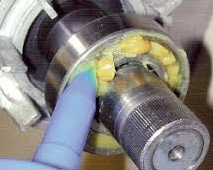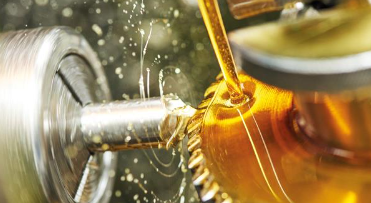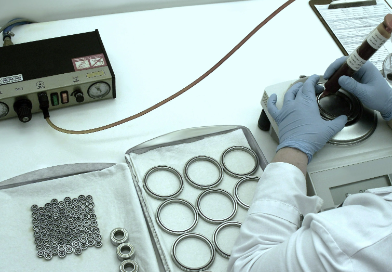Select the right amount of grease for a bearing
Learn how to select the right amount of grease for your bearing.
Proper grease application is essential for smooth and efficient bearing operation.
As a bearing user or maintainer, selecting the right amount of grease is essential for optimal performance and longevity.
In this article, we'll explore the factors to consider when determining the appropriate amount of grease to use for your bearings.
The amount of grease to use on a bearing depends on factors such as bearing type, size, application speed, operating temperature, and load capacity.
To select the right amount of grease, follow these steps:
1.Clean the bearing before applying grease.
2.Determine the correct amount of grease using manufacturer recommendations and other factors.
3.Apply the grease evenly.
4.Recheck and adjust as needed.
By following these steps, you can ensure that your bearings are adequately lubricated and will operate smoothly and efficiently for longer.
Factors to Consider When Determining Grease Amount

A. Bearing type:
The type of bearing used plays an important role in determining the amount of grease required for lubrication.
Different bearing types have different designs, which affect how the grease is distributed within the bearing.
For example, a ball bearing has a smaller surface area than a roller bearing, which means it requires less grease to lubricate properly.
Additionally, the type of bearing can affect the speed and temperature at which it operates, which can influence the amount of grease required.
Therefore, it is important to consider the bearing type when determining the amount of grease needed.
B. Bearing size:
The size of the bearing also plays a critical role in determining the amount of grease required.
Larger bearings have more surface area, which means they require more grease to lubricate properly.
However, it is important to note that bearing size alone cannot determine the amount of grease required.
The bearing's design, application speed, and temperature must also be taken into account.
C. Application speed:
The speed at which the bearing operates is another critical factor to consider when determining the amount of grease required.
Bearings that operate at higher speeds require more frequent lubrication and more grease to ensure proper lubrication.
Conversely, bearings that operate at slower speeds may require less grease to maintain proper lubrication.
It is essential to consult the manufacturer's recommendations for the specific bearing and application speed.
D.Operating temperature:
The temperature at which the bearing operates also plays an important role in determining the amount of grease required.
Higher temperatures can cause the grease to break down more quickly, requiring more frequent lubrication and more grease.
Conversely, lower temperatures may require less frequent lubrication and less grease.
In extreme cases, high temperatures can cause the grease to melt and flow out of the bearing,
while low temperatures can cause the grease to thicken, making it harder for the bearing to function.
The operating temperature of the application must, therefore, be taken into consideration.
E. Load capacity:
The load capacity of the bearing is also a critical factor in determining the amount of grease required.
Bearings that are subjected to higher loads require more frequent lubrication and more grease to ensure proper lubrication.
On the other hand, bearings that are subjected to lighter loads may require less frequent lubrication and less grease.
The manufacturer's recommendations should also be considered when determining the amount of grease required.
F. Manufacturer recommendations:
Finally, the manufacturer's recommendations must be considered when determining the amount of grease required.
The manufacturer will have tested the bearing under various conditions and will be able to provide specific recommendations on the amount of grease required for proper lubrication.
Following the manufacturer's recommendations ensures that the bearing is lubricated properly and that it will function as intended.
Additionally, following the manufacturer's recommendations may be necessary to maintain the warranty or ensure the safety of the equipment or machinery.
Methods for Applying Grease

A. Manual method:
The manual method of applying grease involves manually applying the grease to the bearing using a grease gun or other manual lubrication device.
This method is suitable for smaller applications or where equipment is not easily accessible.
It is also a suitable method for equipment that requires lubrication only occasionally.
However, manual lubrication can be time-consuming and may not be suitable for large or complex equipment.
B.Automatic lubrication systems:
Automatic lubrication systems involve the use of mechanical or electronic devices that automatically apply the grease to the bearing at pre-determined intervals.
This method is suitable for large or complex equipment that requires frequent lubrication.
Automatic lubrication systems can reduce equipment downtime and maintenance costs and can improve equipment performance.
However, these systems can be costly to install and maintain.
C. Grease guns:
Grease guns are handheld devices that are used to apply grease to bearings manually.
They are suitable for small to medium-sized applications or where equipment is not easily accessible.
Grease guns are affordable and easy to use and can provide precise control over the amount of grease applied.
However, manual lubrication can be time-consuming and may not be suitable for large or complex equipment.
D. Oil mist lubrication:
Oil mist lubrication is a method of lubrication that involves the use of a mist of oil droplets that are sprayed into the air and directed toward the bearing.
The oil droplets are small enough to penetrate the bearing and provide lubrication.
This method is suitable for high-speed applications and can provide continuous lubrication to the bearing.
Oil mist lubrication can also reduce maintenance costs and equipment downtime.
However, this method can be costly to install and maintain and may not be suitable for all applications.
Steps for Proper Grease Application

A. Clean bearing before applying grease:
Before applying grease, it is essential to clean the bearing thoroughly to remove any dirt, dust, or debris that may have accumulated on the bearing surfaces.
This will ensure that the grease can penetrate the bearing surfaces effectively and provide adequate lubrication.
The cleaning process should be performed using an appropriate cleaning solution and a lint-free cloth.
B. Determine the correct amount of grease:
The correct amount of grease to apply to a bearing depends on several factors, including the bearing type, size, application speed, operating temperature, and load capacity
. The manufacturer's recommendations should also be considered when determining the amount of grease required.
It is essential to ensure that the correct amount of grease is applied to the bearing to ensure proper lubrication and prevent over-lubrication, which can lead to damage or failure of the bearing.
C. Apply grease evenly:
When applying grease, it is important to ensure that the grease is applied evenly to all bearing surfaces.
Uneven application of grease can lead to inadequate lubrication of certain bearing areas, which can cause premature wear or failure.
To ensure even application, the grease should be applied in a circular or figure-eight motion, starting from the center of the bearing and working outwards.
D. Recheck and adjust as needed:
After applying grease, it is important to recheck the bearing to ensure that the correct amount of grease has been applied and that the grease is evenly distributed.
If necessary, adjust the amount of grease applied or the application method to ensure that the bearing is adequately lubricated.
It is also important to periodically recheck the bearing to ensure that it is still adequately lubricated and to perform regular maintenance to prevent problems from developing.
Conclusion
By following these steps, you can ensure that your bearings are adequately lubricated and will operate smoothly and efficiently for longer.
Conclusion: Proper grease application is essential for the smooth and efficient operation of bearings.
By taking the time to select the right amount of grease and apply it correctly, you can prolong the life of your bearings and save time and money in the long run.





